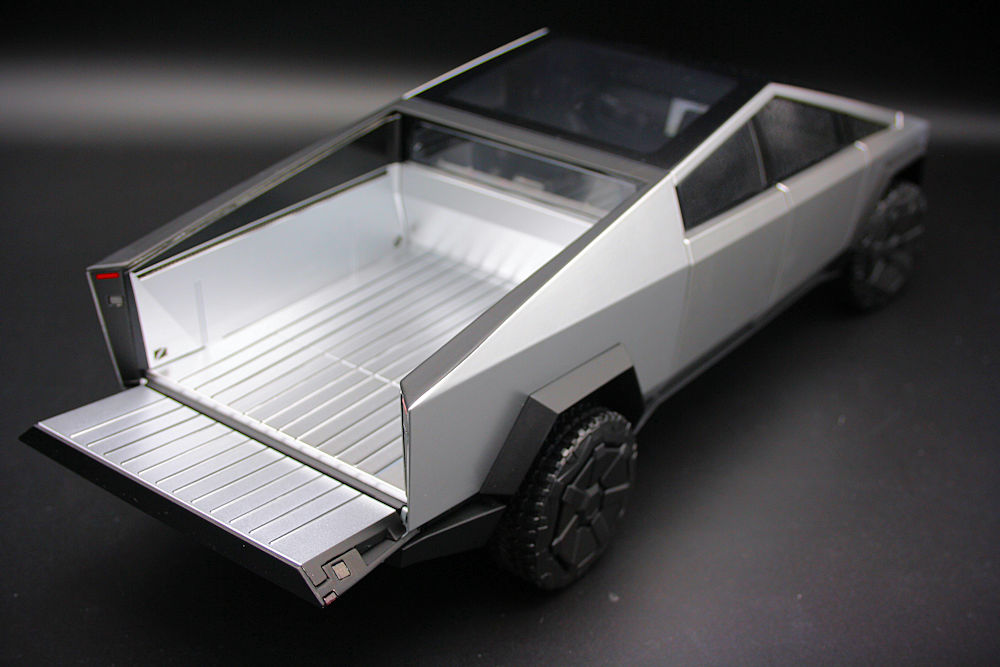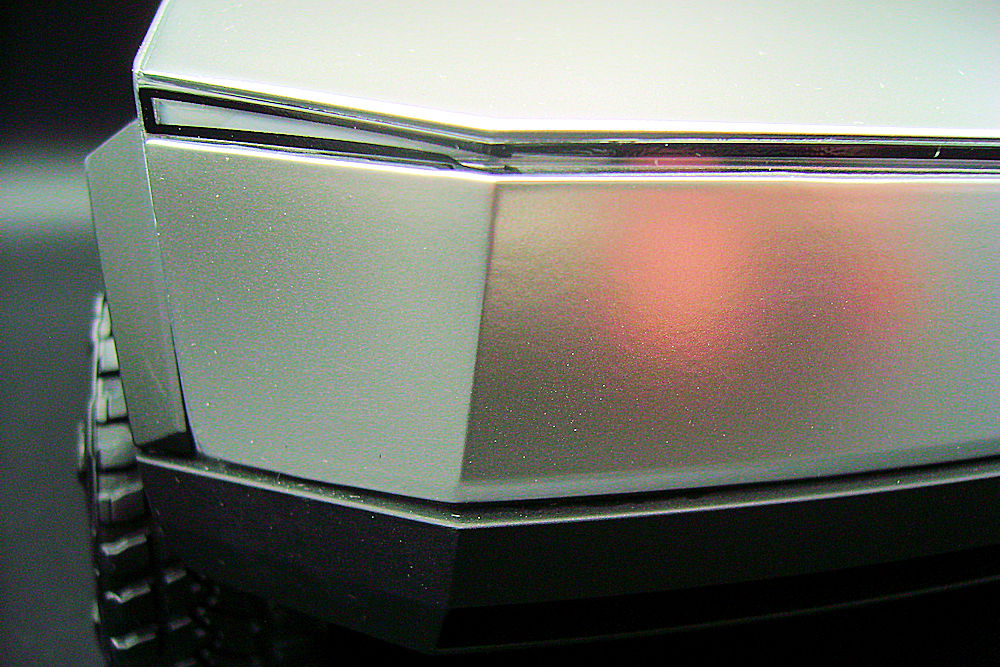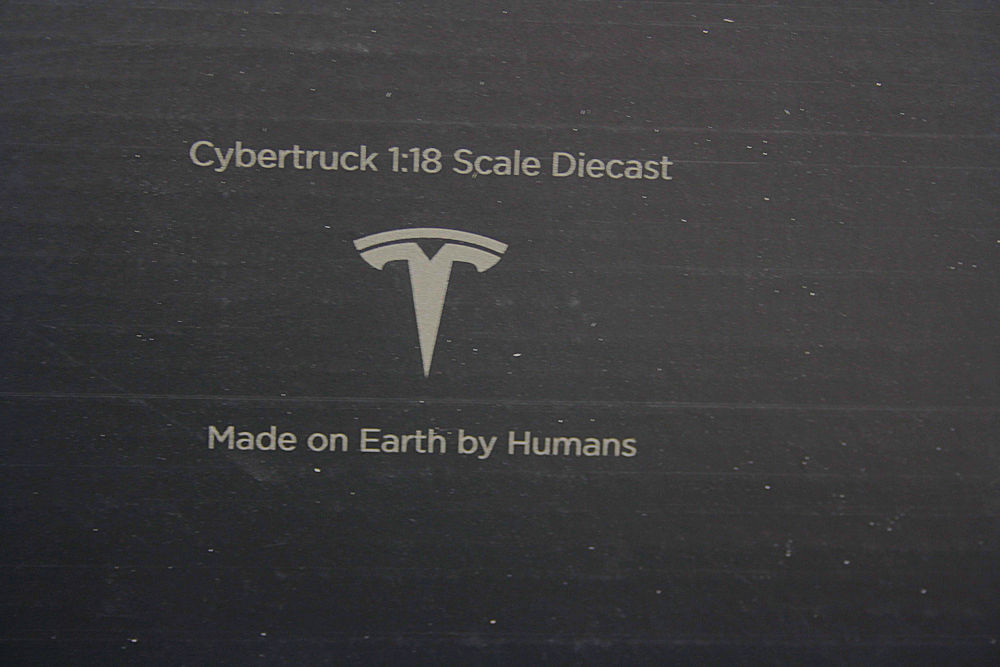Tesla´s Cybertruck and its design surely have been controversial from its inception onwards. Elon Musk and Franz von Holzhausen have kept the production model looking much like the prototype. It still looks outlandishly Sci-Fi utilitarian, the commercial looks aptly as if it had been shot on Mars and the box of our model hilariously tells extraterrestrials that this “Cybertruck 1:18 Scale Diecast” was “Made on Earth by Humans”. Yet some differences between prototype and production vehicles become significant when looking at the OEM model that has been released along with the real (stainless) steel. Tesla´s merchandise says “The 1:18 Scale Cybertruck Diecast was specially designed by the Tesla Design Studio. Every detail, curve and surface is replicated from the same 3D CAD data used to manufacture actual Cybertruck vehicles.”

The production Cybertruck is 5683 mm in length, 2201 in width (without the detachable door mirrors) and 1790 mm in height, which translates into 1/18 scale as 315.7 mm long, 122.3 wide and 99.4 mm high, while the Tesla shop website states the following “dimensions: 328mm long x 125mm wide x 103mm high”. Err, wait a minute. Is this made “from the same 3D CAD data used to manufacture” the prototype or the production model that has been shrunk by 5%? The model´s length is exactly 1:18 of the 231.7 inches of the prototype. This raises suspicions about which version´s features are replicated here.

The prototype still had retractable door handles, while the production vehicle did not. The model does not replicate retracted door handles either, but keeps the surface smooth. The stainless steel imitation is key on this model, just like on any DeLorean model. One Youtuber said the panels were plastic, but they are clearly metal and the stainless steel effect has been achieved sufficiently enough, not AUTOart DeLorean level, but credible. But there are differences in the brightness of the body parts, with the driver´s door, in particular, standing out most obviously as extremely brighter in my example.

The model´s front bumper is narrower than the bulkier one on the production vehicle and the stubby mudguard extensions at the front wheels of the latter are absent on the model, much resembling the prototype´s design. In context with this, the production truck received headlights just above the front bumper, when the prototype only had the lightbar further up, incorporating the headlights. Again, the model resembles these prototype´s features. Neither does the model have the production vehicle´s opening frunk or the world´s largest windscreen wiper on that giant sloping windscreen. As Tesla has deliberately made the legally mandatory door mirrors removable and provided rear-facing cameras incorporated in the front wheel arches, the model´s missing mirrors may not matter so much. But there is nothing that could be interpreted as the cameras either, again making the model the prototype rather than the production truck.

The pickup comes with the tonneau cover over the flatbed. We did not seriously expect this to roll up behind the crew cabin, it is a flat sheet of plastic sliding out the back. The truck bed has shiny exposed stainless steel as on the prototype, while the production vehicle gets a protective black lining for practicality. The tailgate flips open into an almost, but not quite completely horizontal position and is held up in its closed position by magnets. The first “cargo” delivered with the pickup is a black cardboard box with a suction tool inside.

That will help a lot to achieve access to the greenhouse cabin with Tesla´s promise to find a “carpeted interior, fabric seat belts with buckle details”, which is not true: seat belts, yes, but carpet: no. Unmentioned, you find a center armrest wide enough for three cupholders in a row and of course, in the absence of any other instrumentation, “a map of Cybertruck’s home base displayed on the touchscreen”. Some of the underwhelming impression may be due to the original´s interior admittedly being minimalist spartan, but Norev´s execution further adds to a toyishly cheap impression, e.g. on the centre console´s fit of the plastic parts. The model has the prototype´s steering yoke, not the production truck´s flat “squarecular” steering and the prototype´s digital rearview mirror mounted on the windscreen (instead of the rearview simply displayed on the touchscreen in the final production vehicle).
Yet, only the front wheels are steerable, not the rear wheels that help the production version minimize its turning circle. However, Norev, who is making the Cybertruck for Tesla, did not replicate the rear-wheel-steering on their dealership editions of the Mercedes Maybach S Classes for Mercedes either (That was only done by Almost Real – at about the same price as this Cybertruck). Overall, in comparison with the OEM Tesla models of the Model S and Roadster, the quality has somewhat decreased on this Cybertruck (and the Model Y, also made by Norev). Previous Tesla model cars clearly were made by some more upmarket model manufacturers at the time. But not only Tesla, other car brands like Mercedes and Bentley have turned to Norev for cheaper OEM models too.

In conclusion, this model neither fully resembles the prototype of the Cybertruck, much less its production version, but more the purity of the original design. Thus, the timing of the model´s release coinciding with the reveal of the production version is misleading; in its current form, it could have been released before the production version was unveiled. Tesla´s price policy may be called as controversial as the truck itself: “Priced at $310 US, is well above the norm, we suspect this is fueled by the current excitement”, our team suspected upon announcing the model on 6th December.

Two sorts of people bought nonetheless, excited diehard fans … and greedy re-sellers, listing it from $ 400, frequently around $ 500/550 a piece on eBay North America. One extra-terrestrially hyper-capitalist specimen of cyber-sales infected by the goldrush fever, having joined eBay only recently with 1 sale and zero feedback history, accepts bids from US$ 750 or a “buy-it-now” purchase for US $ 1,000 (in words: one THOUSAND US-Dollars !!!), while Tesla US showed it as “out of stock” with a price-drop to $225 just four days later on 10th December, when I had bought mine from Tesla Europe for 200 Euros (= $ 215) on 8th December, with the model still available for that same price in Europe at the time of writing this. If you are on the fence for this one, you may well remain seated for a while. The price may drop further when the initial hype surrounding every Tesla release, purposefully fueled by Elon Musk´s marketing machine, has cooled off. On the other hand, 200 Euros /225 $ US for this sizeable all-open diecast model seems reasonable when put into context with Top Marques´ announcement of the Cybertruck (in sealed resin) for next year at 280-330 Euros.















Thank you sir for this in-depth review. You can see the model’s limitations in photos and words. Excitement is fueling prices for sure! But there are alternatives to eBay…
There are still plans to add one to the collection in due time. It’s another disruptive entry from Tesla (lol some may use the word ugly!). Kudos to the metal and opening features.
This model is joke as real car. So true replica.
Thanks for the review, can’t believe people are paying that much money for such a mediocre model of an even more mediocre car. Prices will go down for sure.
At least I’m glad I won’t be seeing one of these on the streets for quite a long time, as they are illegal in all of Europe for them being extremely insecure lol!
LOL!
that says a lot about Tesla fans, they have more money than sense
750 – 1000$ ??!! I really don’t get the Cybertruck hype.. This is even uglier than the Pontiac Aztek in my opinion.. :))
It’s not the first time this car has made in scale form.
https://www.youtube.com/watch?v=s_YCzEV3cio
LOL!!!!!!
I would consider buying it only as hard discounted at sub 100€ and merely as a curiosity and then display it with some regular size\design vehicle to highlight its weirdness.
No amount of money would be worth it to buy this monstrosity, in my opinion. Who designed this vehicle — Dr. Frankenstein? Hands down, this should win the booby prize for “Ugliest Model of the Year”, if not “Ugliest Vehicle of All Time!”
The vehicle is highly disruptive both in its design and its advanced tech well above what the industry has in store right now. Basically pick-up trucks have not fundamentally evolved since the 1950’s and all of a sudden we see a plethora of new technology never seen before on this type of vehicle (structural battery, front & rear mega-castings, exoskeleton stainless-steel panels, first 48V low voltage system, Etherloop wiring, brake by wire with 4-wheel steering… The rest of the industry will eventually catch-up in many years. But the cybertruck will remain and icon just like like the Coutnach is now an icon for 70’s supercars. Yes it’s design is controversial and it is a love it or hate it type of vehicle. I personally love it. To each it’s own taste. BTW I like your you-tube podcast so I must have some, LOL.
Well said… There’s a good YouTube video that goes into depth on the history of the pickup truck. Kudos to Tesla for swinging to the rights!
Was looking at the real thing the other day and wondered how could that extremely sharp rear edges get approved for production? Isn’t it a big time safety hazard?
How much do you have to dislike cars to create this monster?
** THIS POST WAS EDITED, SELECT COMMENT(S) DID NOT MEET WITH DS CODA **
Reminds me another “coffin on wheels” named Lo Res Car, reviewed by Doug DeMuro some time ago :)